Tech Burner, founded by Delhi-based Shlok Srivastava, is a YouTube channel dedicated to consumer technology, with a reach of 50 million viewers a month. But he recounts how his life would’ve been vastly different if he had chosen the IIT path.
For 25-year-old Shlok Srivastava, aka Tech Burner, who ranks among the fastest-growing technology influencers in India with 6.36 million subscribers on just YouTube, not securing admission into the prestigious Indian Institute of Technology (IIT) was a “liberating experience”.
Like many children born into middle class households who have an aptitude for science, Shlok was pushed into the rat race of scoring good marks in the Joint Entrance Examination (JEE), which decides whether a student obtains a seat in India’s finest engineering institutions.
“Any child remotely good in academics with an interest in science is pushed into an extremely competitive environment. So, I did the whole nine yards of coaching classes, tuitions and put myself under a lot of pressure. My parents didn’t necessarily put serious pressure on me, but there is an intensely competitive environment fostered among students who study science in high schools [Class 11 and 12] and attend coaching classes. The environment, particularly in coaching centres, where they harbour that ‘rat race mentality’ for seats, creates an intensely competitive culture. Making matters worse are the expectations of people around you like your peers, relatives and family members. Therefore, when you fail the impact on your life is a lot harder than it otherwise should be,” says Shlok.
Sholk admits he hadn’t experienced failure before.
He was a good student in school but the expectations of getting into IITs were so high that he felt that it was his destiny. When he failed, it was a blow that would take him at least three months to recover from.
“For three months after the JEE results came out, I felt like a failure. But I had to reassess whether I was really a failure or not. During this process, I had to reevaluate myself, my goals and what I wanted from this life,” he says.
“The first thing I realised is that real life isn’t as competitive as coaching centres where the student next to you wouldn’t even share their answers. You can seek and get help. Also, during this process, I researched many successful people. What I figured was that the biggest personalities suffered the biggest failures and the real winners in life are not those who have failed, but those who haven’t stopped. In my mind, I knew that I was a winner no matter what anyone else said,” he asserts.
Instead of IIT, Shlok took admission in SRM University, Chennai, in 2014. After failing to get into the IITs, he was open to starting from scratch. There was a feeling within that he could now do anything with no added pressure. As a result, he was able to explore different things in college from design, theatre and of course making videos on YouTube.
Today, the Tech Burner channel is one of the most-viewed YouTube channels in India dedicated to consumer technology with each video garnering an average of 1-2 million views. Shlok entered the influencer marketing industry sometime in 2014 when it was still in its infancy. But for him, it was all about creating content for different audiences and building human connections on a level that brands are unable to achieve through conventional forms of advertising.
Backed by a quirky and entertaining style of storytelling in colloquial Hindi interspersed with some English, Tech Burner today features the latest news on laptops, mobile phones and computers, ‘How To’ tutorials on gadgets and appliances, product reviews, and comparisons along with various life hacks making it a one-stop-shop for all things related to technology.
Shlok has leveraged the growing popularity of the Tech Burner channel, which racks up a reach of 50 million viewers a month, and launched two separate websites (techburner.in and burnerbits.com) and five online applications under another venture called Burner Media.
Both websites and the apps make revenue from advertisements and brand partnerships like the Tech Burner channel has been doing for the past few years. Meanwhile, he has recently launched a ‘premier value clothing line’ called Overlays. Combining all these ventures, he employs about 20 people full time with another 10 on a freelance basis.
Evolution of a Content Creator
Before Shlok became Tech Burner, he was just a curious Class 11 child making amateur videos. But coming from a regular middle class family in Delhi, he didn’t have access to his own mobile phone, laptop or gadgets of that nature.
“The first videos I made were on my father’s laptop issued to him by his office. I started Tech Burner in college. Over the course of four years at SRM University, I was able to garner a steady following on YouTube with about 5,000 subscribers,” he recalls.
He was offered a job after graduating from college. But in a risk not many would take, he dropped the job offer and dedicated himself full time to his YouTube channel, which at the time was paying less than Rs 2,000 per month. The decision to give up the job offer wasn’t received well by his family.
“There was no doubt about what I wanted. In my mind, I knew this would work. So, I taught myself how to speak in front of a camera and make quality videos on YouTube. For a lot of YouTubers or other influencers on social media, there is one viral moment, which could include a video or a set of videos that do very well with an audience. I didn’t have that one viral video that changed the trajectory of my YouTube channel,” he explains.
His early videos on YouTube were addressing very niche tech problems.
For example, how do you install a lollipop calendar in your MotoG smartphone. He would make videos about a specific phone and small features in it that didn’t work or how you could install a particular feature. Back then, barely 1,000-2,000 viewers would watch these videos. Since Shlok couldn’t afford to buy new phones in college, he would work with mobile phones that belonged to his college friends, batchmates or mother.
“The intention was to always provide value to my audience. The objective was to make people’s lives easier when using a given gadget. Over time, I just took that objective and scaled it up. From one Motorola phone, I started talking about issues common to different mobile phones and what users could do to fix them. The channel shifted from discussing very niche technology to things that everyone was using. For example, I made a video about the Android USB adapter hacks that users should know about, which they can deploy in every phone. Another such video we made was the five best Android apps users must try. Over time, we transitioned from addressing phone software to hardware, and began reviewing the newest phones in the market. The approach was to make content that everybody can watch and learn from,” he says.
His approach, however, has never been dull. Most people on social media want to be entertained first. To entertain people and teach them along the way is a very well crafted art. That’s what he started to learn over the course of his evolution in content creation. “If we can entertain people and in the process they learn something, it’s an extremely rewarding process. That is the approach we took to spread information and create value for our audience,” he adds.
Take the example of a video he published a week ago called ‘I Turn my Table Into a Gaming Computer’, where he teaches his audience how to assemble a computer in a manner which is both teachable and fun. Besides value in terms of knowledge, what one can see is a desire to make tech fun as well with some laughter and jokes (albeit poor ones).
His phone reviews also exhibit a similar spirit giving specific attention to consumer needs. His review of the latest Apple iPhone 13 Pro, which has garnered over 1.4 million in just five days, doesn’t go overboard with praise or criticism.
Another significant point of evolution in his content creation process was the transition from English to Hindi, which happened sometime in 2018 after he came to Delhi. He even announced it on his YouTube channel.
“That transition to Hindi happened when I left Chennai and moved to Delhi in 2018. On one particular auto rickshaw journey home in Delhi, I showed the driver one of my videos. He didn’t understand the content because it was in English. That’s when I realised that there are many others like him who wouldn’t be able to watch my videos because they’re in English. That’s when I started making videos in Hindi,” he explains.
- Delhi
- team@techburner.in
- https://techburner.in/?fbclid=IwAR3v2ppgnTBDqFgKzeEVSj0oIAWjDZ8WUrMIZLZY4rh8h7mXOf4xAscgdRI




Add new comment